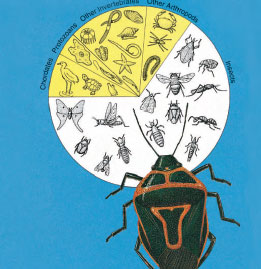Terrestrial Mandibulates
 |
| The majority of animal species is composed of insects. |
-
Tunis, Algeria—Treating it as an invading army,
Tunisia, Algeria, and Morocco have mobilized to fight
the most serious infestation of locusts in over 30 years.
Billions of the insects have already caused extensive
damage to crops and are threatening to inflict great
harm to the delicate economies of North Africa.*
How can we account for the enormous numbers of these creatures? In common with other arthropods, insects have a combination of valuable structural and physiological adaptations, including a versatile exoskeleton, segmentation, an efficient respiratory system, and highly developed sensory organs. In addition, insects have a waterproofed cuticle, and many have extraordinary abilities to survive adverse environmental conditions.
In this section we introduce animals commonly placed in subphylum Uniramia. Some scientists now question the validity of a taxon “Uniramia,” but we tentatively retain the grouping. We discuss the controversy further under Phylogeny. Uniramians are primarily terrestrial arthropods. Only a few have returned to aquatic life, usually in fresh water.
The term “myriapod,” meaning “many footed,” is often used for a group of four classes of uniramians that have evolved a pattern of two tagmata—head and trunk—with paired appendages on most or all trunk somites. Myriapods include Chilopoda (centipedes), Diplopoda (millipedes), Pauropoda (pauropods), and Symphyla (symphylans).
Insects have evolved a pattern of three tagmata—head, thorax, and abdomen—with appendages on the head and thorax but greatly reduced on or absent from the abdomen. The common ancestor of insects may have resembled a myriapod in general body form.
Uniramians have only one pair of antennae, and their appendages are always uniramous, never biramous like those of crustaceans. Although some insect young are aquatic and have gills, the gills are not homologous with those of crustaceans.
Insects and myriapods use tracheae to carry respiratory gases directly to and from all body cells in a manner similar to onychophorans and some arachnids.
Excretion is usually by malpighian tubules.




